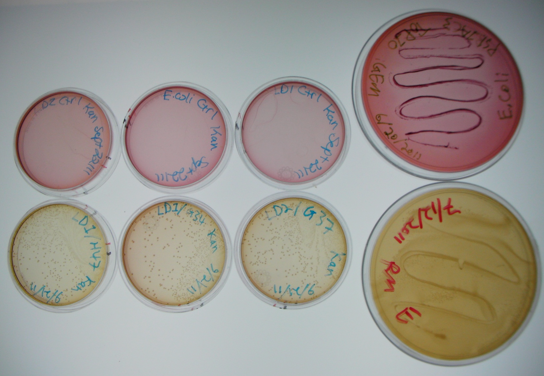Difference between revisions of "Part:BBa K640004"
Emily Hicks (Talk | contribs) |
Emily Hicks (Talk | contribs) |
||
| Line 2: | Line 2: | ||
<partinfo>BBa_K640004 short</partinfo> | <partinfo>BBa_K640004 short</partinfo> | ||
| − | + | This device contains an origin of transfer and an ori1600 origin of replication, allowing for parts to be conjugated between E. Coli and Pseudomonas. | |
<!-- Add more about the biology of this part here | <!-- Add more about the biology of this part here | ||
Revision as of 04:27, 29 September 2011
Device for conjugation of plasmids from E. coli to pseudomonas
This device contains an origin of transfer and an ori1600 origin of replication, allowing for parts to be conjugated between E. Coli and Pseudomonas.
Sequence and Features
- 10COMPATIBLE WITH RFC[10]
- 12COMPATIBLE WITH RFC[12]
- 21COMPATIBLE WITH RFC[21]
- 23COMPATIBLE WITH RFC[23]
- 25COMPATIBLE WITH RFC[25]
- 1000COMPATIBLE WITH RFC[1000]
Functionality Test
In our first assay, we wanted to see that our BBa_K640004 (oriT-ori1600) construct was working. We incubated the co-cutures for 12 hours at 37°c prior to plating. The plates were then left to grow overnight.
Results

The large plates on the right show controls of Pseudomonas and E. coli on MacConkey plates indicating the normal expected colors for these organisms. The small plates on the bottom represent our construct, conjugated with two different strains of pseudomonas and plated on MacConkey agar with Kanamycin (50ug/mL). The yellow color indicates that the colonies are Pseudomonas. The small plates on the top show our two strains of Pseudomonas, as well as E. coli without kanamycin resistance plated on MacConkey agar plates with kanamycin (50 ug/mL). All of these plates are pink in color, and show no colonies. This was expected, as it shows that without a resistance marker, these organisms are not able to grow on the MacConkey kanamycin plates. This demonstrates that our part is working the way we expect it to!
